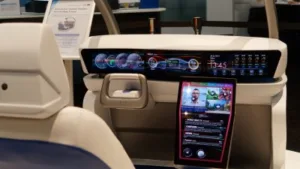JDI always has an impressive range of displays both in terms of technology and also in applications. Although the company has had some serious financial issues because of its over-reliance on a small number of customers, such as Apple.
Automotive displays are an important application and JDI has a range of LCD-based solutions for different applications in a car, including instrument clusters, centre consoles, passenger areas and rear view mirrors.
JDI has a 16.7″ LCD for CIDs that has 1800 x 2880 16:10 resolution (in the rectangular display area). The display can be concave (R800) and the brightness is 800 cd/m². The display includes the JDI Pixel Eyes integrated touch function and the backlight has local dimming for maximising contrast.
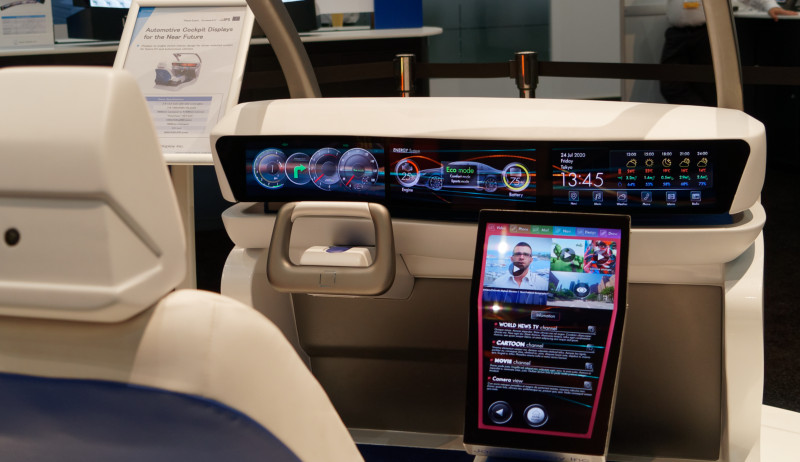 JDI has LCDs for all areas of cars. Image:Meko
JDI has LCDs for all areas of cars. Image:Meko
JDI has been working hard to meet the competition from OLED with its LCD displays. The company can offer a range of curves from 800mm to 1500mm. The company was showing four LCDs in the ‘standard’ 2/3 LCD format of 1920 x 720 and 12.3″ diagonal, with a single cover class to unify the look of the setup. The LCDs have output of 1000 cd/m² and they are curved at R1500.
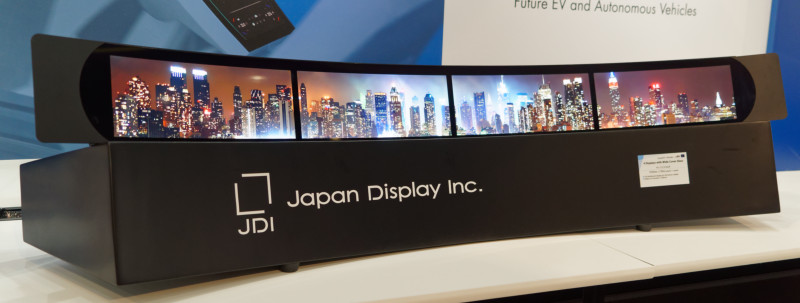 JDI showed four curved displays unified with a single cover glass and intended for automotive applications. Image:Meko
JDI showed four curved displays unified with a single cover glass and intended for automotive applications. Image:Meko
Next, we looked at the E Ink displays that the company has developed up to 30cm wide and with up to 200ppi, now. It also has a new module that is 7.5cm wide.
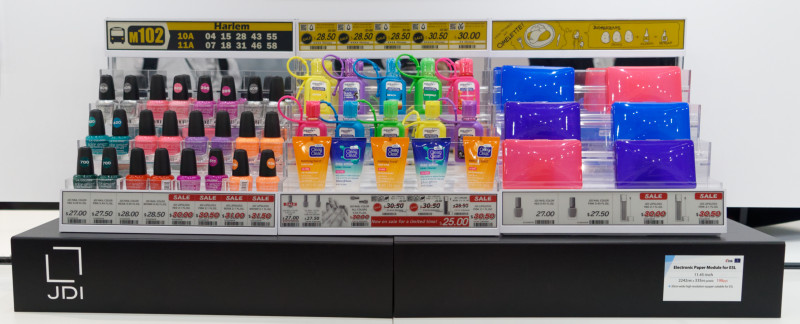 JDI has been developing its E Ink displays and can now supply them up to 30cm wide.
JDI has been developing its E Ink displays and can now supply them up to 30cm wide.
JDI has been a supplier of panels for medical monitors for a number of years and had new versions of its medical monitors which have narrower bezels, with the width reducing from 10mm in the previous generation to 5.57mm in the case of the 3 megapixel colour LCD and to 5.54mm in the case of the 5M mono version. The panels are, of course, based on IPS technology and have substantially reduced power reduction, down by 31% for the colour version to 36.6W, while the mono panel drops by 38% to 39.12W. JDI believes that this will mean that monitors can be made fanless.
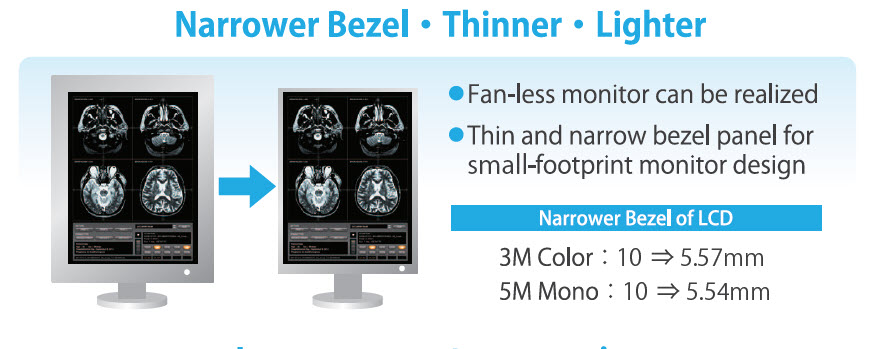 Narrower bezels mean that radiology displays can be closer together.
Narrower bezels mean that radiology displays can be closer together.
Developing a wider colour gamut has been a challenge because of the difficulties of getting to Rec. 2020 and JDI has adopted a laser-based backlight system and new a revised colour filter to get to 97% of the full Rec. 2020 gamut , the highest that we have seen from an LCD so far (although AUO also had a paper – 71.4 – about an optimised optical stack and filter and using QDs is also claimed to have got to 97.3% of Rec. 2020.). The panel is a 17.3″ 8K unit (510 ppi) and the unit is said to have special treatment to eliminate the speckle, which so often affects laser-based displays. The treatment is applied to the LGP in the backlight and JDI told us that the display was developed in collaboration with NHK in Japan, which starts its 8K broadcast tests later this year.
 This panel uses laser backlights and gets to 97% of Rec. 2020 gamut. (Image:Meko)
This panel uses laser backlights and gets to 97% of Rec. 2020 gamut. (Image:Meko)
JDI then showed us a transparent display (80%) that it has made that works by beaming light around the display using TIR and then using materials to frustrate the TIR, which causes the light to be emitted. The panel uses a frame sequential system for colour and the display refreshes at 60Hz per colour (180 Hz in total). Resolution on the panel is 300 x 360 on a 4″ diagonal (117 ppi)
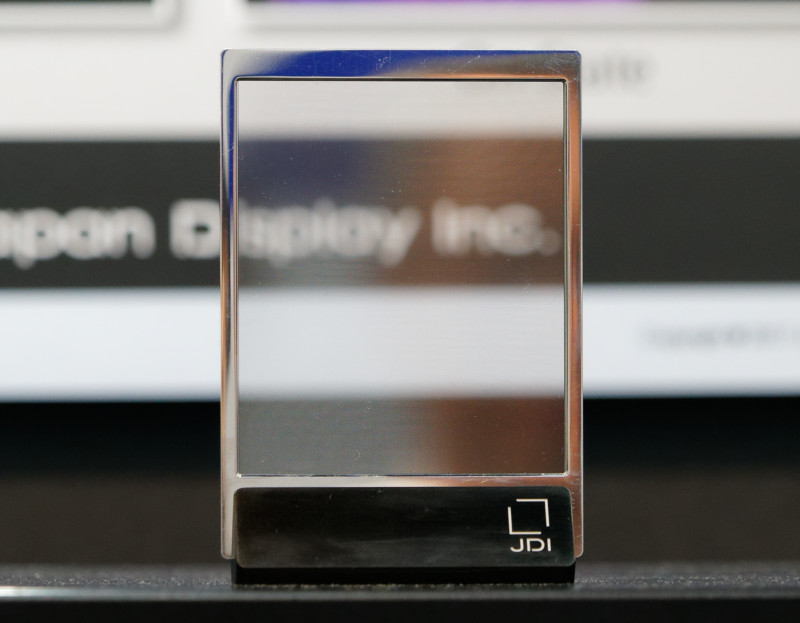 This transparent display goes up to 80% transparency. Image:Meko
This transparent display goes up to 80% transparency. Image:Meko
Next we looked at a flexible plastic OLED that has FullHD resolution and 5.5″ diagonal (401 ppi), so would be suitable for use as a smartphone display. Peak brightness (10% area) is 700 cd/m². Contrast is 100,000:1 and colour gamut is 110% of DCI P3. The panel was shown as a ‘technology demo’ as the plan for mass production is for 2019, at the company’s G4.5 plant in Ishikawa.
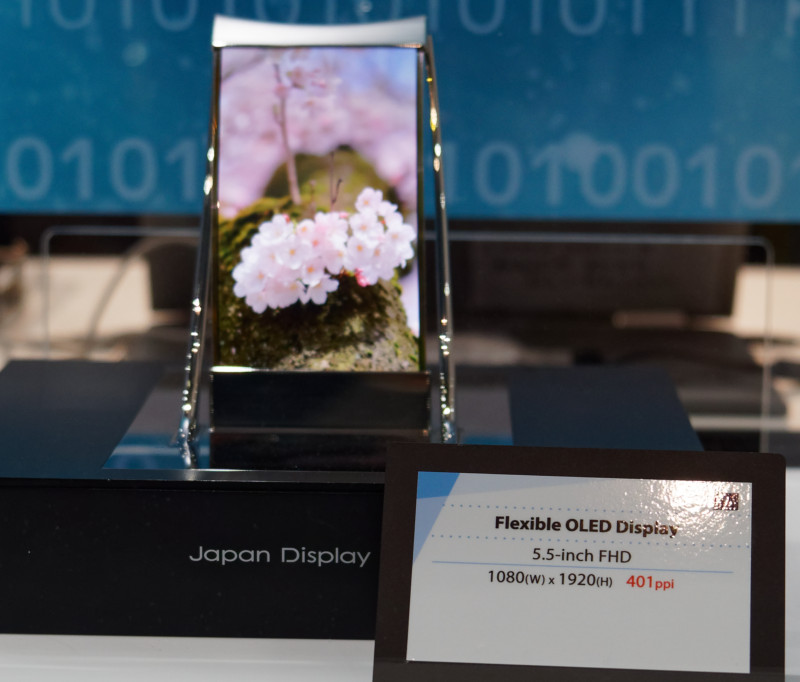 This flexible OLED is intended for production in 2019. Image:Meko
This flexible OLED is intended for production in 2019. Image:Meko
A very innovative LCD was a new design that uses a mixture of LTPS and Oxide TFTs. This was the first time that we have seen such a configuration and the technology highlights that JDI might have been having a hard time commercially, but it is still a technical powerhouse.
The display is built on an LTPS TFT substrate to support integrated drivers, but has oxide TFTs in the active area which means that there is lower leakage than when LTPS is used for the whole substrate and this enables low frame rate operation for adaptive low power modes.
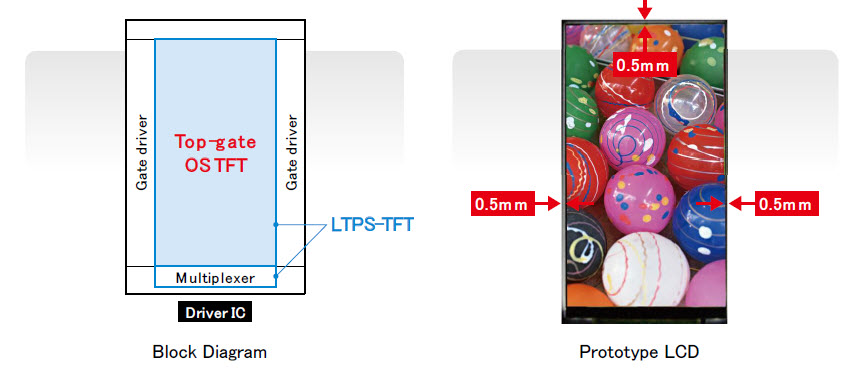 This concept combines LTPS and Oxide to get the best of both technologies.
This concept combines LTPS and Oxide to get the best of both technologies.
As well as the flexible OLED, JDI told us that its 5.99″ ‘Full Active’ 1080 x 2160 LCD display is now being used in a number of products including the Xiaomi Mix2. The technology supports slim borders on all four sides with a ‘corner cut’ on the top corners and produces 585 cd/m². Another version of this panel with 1440 x 2880 resolution and 400 cd/m² is used in the HTC U11+
The next products we were shown were 800 ppi (JDI Adds New Display For VR) and 1000 ppi VR displays (JDI Boosts LCD PPI to 1000 for VR) which were announced some time ago, but this was the first time we had had a chance to look at them. The panels looked better than the Samsung panel in terms of the ‘screen door’ effect. The 800 ppi version goes up to 90Hz refresh, but the 1000 ppi 3.25″ panel (2160 x 2432 – 1001 ppi) goes up to 120Hz as well as supporting backlight blinking for better motion performance.
 JDI has pushed dot densities up to 1000 ppi.
JDI has pushed dot densities up to 1000 ppi.
Finally in the JDI part of the booth, we looked at technology to detect fingerprints. The system uses capacitive touch and there were two versions, one at 8 x 8 mm with 160 x 160 resolution, the other that was 10.46 mm x 13.95 mm with 192 x 256 resolution with 256 grey scales. The company expects to see applications in home security and financial transactions.
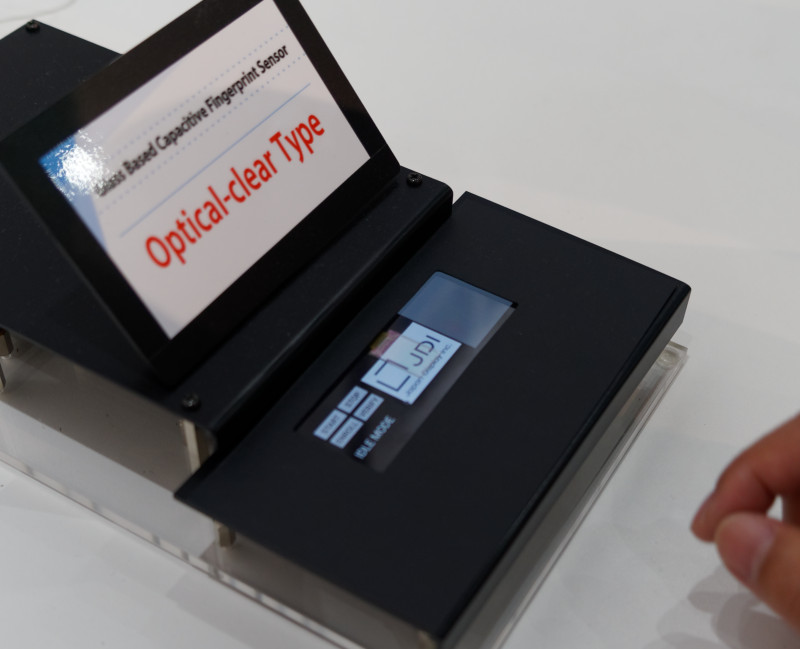 JDI has developed fingerprint sensors. Image:Meko
JDI has developed fingerprint sensors. Image:Meko
KOE is the division of JDI that develops and markets industrial panels based on IPS displays from JDI. The company was highlighting its value add technologies such as high resolution and optical bonding and there was a good looking 13.3″ monitor that is currently sampling. It has 3840 x 2160 resolution and has 350 cd/m² with 1,500:1 contrast.
The company also has bright displays including a 6.4″ 1024 x 768 monitor with 1,400 cd/m² of output and 800:1 contrast. The monitor is based on LTPS. A 10.3″ 1920 x 720 panel produces 1,200 cd/m² and with 1,300:1 contrast.
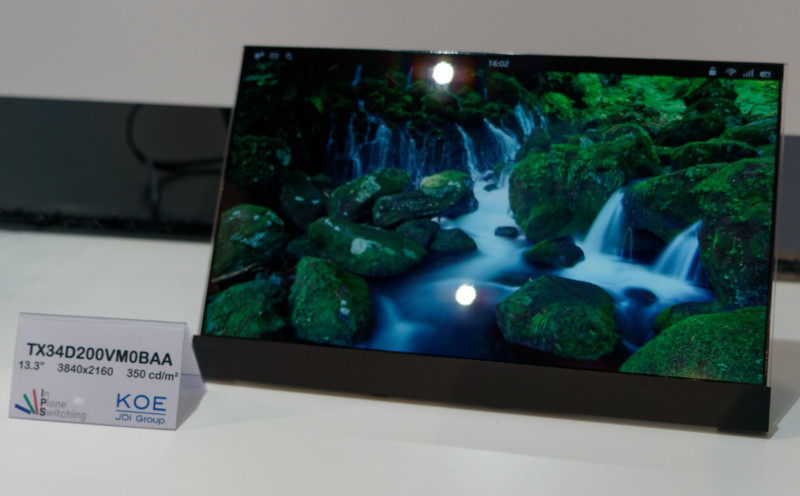 KOE’s 13.3″ LCD looked very good.
KOE’s 13.3″ LCD looked very good.
Analyst Comment
JDI also had an impressive looking light field display, although Chris thinks it’s just an autosterescopic display (Japan Display Inc Shows 8K based Light Field Display) (BR)

